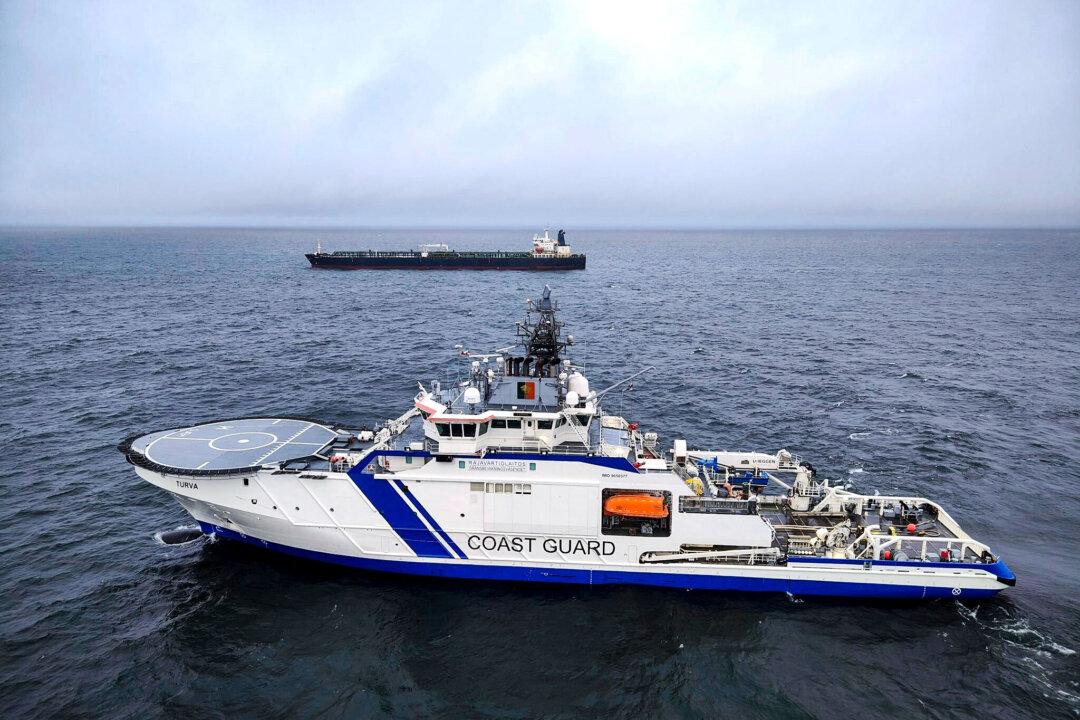Russia has been growing its so-called shadow shipping fleet for several years but concerns have escalated in the past few months after some of them were linked to a series of incidents involving undersea infrastructure.
Germany, the UK, and 10 other European countries agreed in December 2024 on measures to “disrupt and deter” Russia’s shadow fleet.
But what is the shadow fleet, why does Russia need it, and can it be disrupted without breaking the international laws of the sea?
4 Types of Fleet
He told The Epoch Times there are four types of fleet.“There’s the Western-administered A1 fleet which has all the right insurance and controls,” he said. “Then, there’s a parallel fleet, run by China, India, and the Asian countries, which is well-maintained but does not follow sanctions.
“Then, there’s the ‘gray fleet’, which is ships used for smuggling drugs and arms, completely illegal. But then you have the Russian fleet, which they have acquired. Some of it is of a reasonable quality but other vessels are older.”
The term shadow suggests they are secretive, but Roberts said they operate openly and use international shipping lanes, including the Suez Canal.
The ships—which often have a confusing array of aliases—have been plying the world’s seas since long before Russia invaded Ukraine in February 2022. But the conflict and the growing tension with NATO has drawn them into focus.
Not only is the shadow fleet suspected of breaking sanctions, but also, some of the ships are alleged to have tampered with undersea infrastructure, and others are feared to be so old or poorly maintained that they might cause marine pollution.
The following day, the Estonian navy was drafted in to protect the Estlink-1 cable, and the European Union’s foreign policy chief Kaja Kallas said the Eagle S incident was “the latest in a series of suspected attacks on critical infrastructure.”
Last month, the UK, Denmark, Sweden, Poland, Finland, and Estonia said they would begin checking insurance documents of vessels in the English Channel, the Gulf of Finland, and the Kattegat—the strait between Denmark and Sweden.
Estonian Prime Minister Kristen Michal said: “If the ships do not cooperate, next steps will be taken. They will be put on a list for prohibition, or they will be boarded in certain areas.”
Roberts said those actions bring up the question of legality, saying it might be a moot point during conflict that but there is no relevant conflict.
During World War II, Allied ships would frequently board and take over German, Japanese, and Italian commercial vessels—or sink them—but because the only countries who are at war here are Russia and Ukraine, there is no “declared conflict” that would permit such action by third parties.
The 1857 Copenhagen Treaty states no ship is to be stopped while traveling through the straits between Denmark and Sweden. It was a clause that was scrupulously adhered to throughout the Cold War, when Soviet submarines and battleships would pass through on their way to the open seas.
He said one of the biggest concerns of the Western shipping industry is what would happen if a shadow vessel were to collide with a ship or cause a major pollution event.
Lloyd’s of London is one of the world’s biggest shipping insurance markets, and the Lloyd’s Market Association represents 55 managing agents who together insure shipping and other assets worth 52.6 billion pounds ($64.2 billion).
Roberts said, “The question that everyone is asking is: ‘What happens if an insured vessel collides with a sanctioned vessel?’”
Shadow fleet vessels are often subject to obscure ownership and an insurance structure that allows them to evade detection and sanctions.
But Roberts said that while shadow fleet ships need a higher grade of insurance to enter a Western port, all they need to sail the high seas is protection and indemnity insurance, known as P&I.
‘Bankroll His Illegal War’
In its statement on Jan. 6, the UK government said it had now sanctioned more than 100 Russian ships, including 93 oil tankers that “Putin has been using to soften the blow of sanctions and bankroll his illegal war in Ukraine.”Among them were the tankers Ocean Faye, Andaman Skies, and Mianzimu, which the UK claims each carried more than 4 million barrels of Russian oil in 2024.
The UK Ministry of Defense (MOD) released a statement saying the new system, called Nordic Warden, was activated at the beginning of January.
The MOD said Nordic Warden “harnesses AI to assess data from a range of sources, including the Automatic Identification System (AIS) ships use to broadcast their position, to calculate the risk posed by each vessel entering areas of interest.”
The statement said, “Specific vessels identified as being part of Russia’s shadow fleet have been registered into the system so they can be closely monitored when approaching key areas of interest.”
The MOD added, “If a potential risk is assessed, the system will monitor the suspicious vessel in real time and immediately send out a warning, which will be shared with JEF participant nations as well as NATO allies.”
It said JEF’s operational headquarters in Northwood, England, on the outskirts of London, was currently monitoring 22 areas of interest, including the English Channel, the North Sea, the Baltic Sea, and the Kattegat.
Roberts said: “There’s a lot of spoofing going on, which is where you say you’re in one place, and you’re somewhere else. And that’s being done in the eastern Mediterranean a lot, and in the Black Sea.”
There is a legal system governing the world’s seas and oceans, called the United Nations Convention on the Laws of the Sea, which was adopted in 1982 but only came into force in 1994.

He said there is no “right of innocent passage” for foreign ships in a country’s lakes, canals, rivers, or ports. They need permission to enter.
“Then, you have your territorial waters where you’ve got full sovereignty, up to 12 nautical miles,” Roberts said. “Then there’s a contiguous zone up to 24 nautical miles, where you’ve got some ability to intervene if there’s been an offense in your territorial waters.”
“Now, past that, is the EEZ (exclusive economic zone) where, as a country, you’re able to use and exploit marine resources in that area,” he said, referring to the area up to 200 nautical miles from a country’s coast.
“Then, there’s the continental shelf. Not everyone has that, but that’s out to 350 miles, and beyond that is the high seas.
“Anything outside 12 nautical miles, you haven’t got full power. If you start boarding vessels in what would be considered to be international waters without due cause, that would be antagonistic to the country of the vessels that you’re boarding.”
He said the shadow fleet vessels do not all have the same flag.
“They have a variety of flags, so the number of states that you are likely to offend is quite wide, unless you’ve negotiated with them, unless you can prove that you have due cause,” Roberts said.
He said the 10 countries seeking to “disrupt and deter” Russia’s shadow fleet will have to prove the vessels are not engaged in “innocent passage.”
“How that’s done is quite hard,” Roberts said.
There is also the danger that Russia could retaliate by boarding Western ships in areas such as the Black Sea or the White Sea, north of Murmansk, Russia.
Roberts said he questions whether sanctions against Russia can be effective, especially considering Moscow’s trade links with the Chinese regime.
“There’s a Western desire to show support for Ukraine ... and they chose to use sanctions as a way of showing that support,” he said. “And I think there was an expectation they'd be more effective than they were.”
Roberts said President Woodrow Wilson’s idea in 1919 to use economic sanctions was based on the premise that “they should be more terrible than war.”
But Roberts said: “Unless you’re targeting a very small area, you need international support. And this is where the weakness is: They haven’t got everybody onside.”







